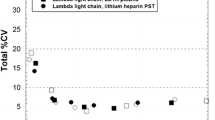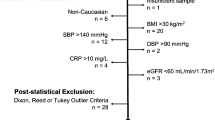Abstract
Objective: The first goal of phase I drug development is the determination of maximal tolerated dose, which must be established by case-by-case analysis, sometimes using a laboratory adverse event. Since no accurate rule defining lab adverse events, has been validated yet, we propose a new “combined method” based on combination of two thresholds: inclusion values and magnitude of variation. Using this combined method, the label “lab adverse event” is applied if any lab value exceeds the inclusion threshold and is associated with a variation from baseline exceeding the variation threshold defined from reference change limit. Thus, this study aimed to test this combined method on a large healthy volunteer population, studied in 19 phase I centres worldwide, and on five lab parameters: alanine amino transferase, aspartate amino transferase, alkaline phosphatases, creatinine and polymorphonuclear leukocytes. Methods: The inclusion threshold from each center was used. Reference change limits were defined from volunteers previously included in comparable studies and were expressed as absolute values: increases of 10 IU · l−1 for alanine amino transferase or aspartate amino transferase, 15 IU · l−1 for alkaline phosphatases, 15 μmol · l−1 for creatinine and a 0.34 109 · l−1 decrease for polymorphonuclear leukocytes. Comparison between the “combined method” and a normal range method was made using positive predictive value and a ratio between relevant and irrelevant results. This application was implemented in all young healthy volunteers (1134) included in 38 phase I studies sponsored by Rhône Poulenc Rorer from 1991 to 1993. Results: Seventy seven subjects (6.7%) were indicated in final study reports as having a lab adverse event (reference group). Of 179 subjects with lab abnormalities defined by the normal range method, 77 belonged to the reference group, inducing a poor 0.43 positive predictive value. Of ninety subjects with lab adverse events defined by the “combined method”, seventy-five belonged to the reference group, inducing a two-fold higher 0.83 positive predictive value. The combined method produced a high ratio of relevant/irrelevant results () compared with the low ratio () achieved using the normal range method. Conclusion: This new “combined method”, leading to a better definition of lab adverse event, seems an accurate and useful tool for routine case-by-case analysis within phase I drug development studies.
Similar content being viewed by others
Author information
Authors and Affiliations
Additional information
Received: 20 June 1996 / Accepted in revised form: 4 November 1996
Rights and permissions
About this article
Cite this article
Sibille, M., Bresson, V., Janin, A. et al. Critical limits to define a lab adverse event during phase I studies: a study in 1134 subjects. E J Clin Pharmacol 52, 81–86 (1997). https://doi.org/10.1007/s002280050254
Issue Date:
DOI: https://doi.org/10.1007/s002280050254




